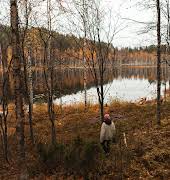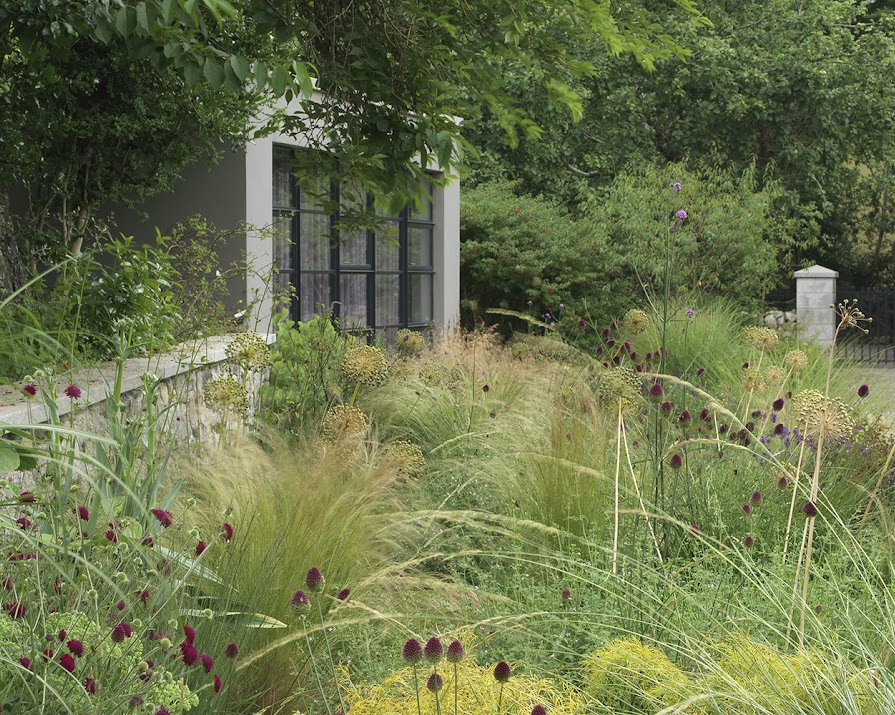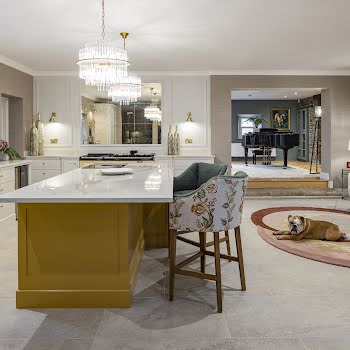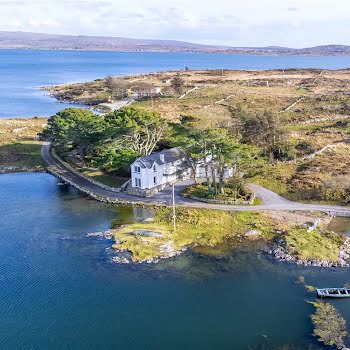
By IMAGE Interiors & Living
11th Feb 2024
11th Feb 2024
A two-and-a-half-acre country garden in Wicklow, designed by the well-known nurseryman Oliver Schurmann of Mount Venus Nursery, it generously blurs boundaries to blend into its spectacular surrounding landscape.
Ever since the 20th-century garden designer Russell Page wrote movingly about “spirit of place” in his famous memoir The Education of a Gardener, it has become a phrase much bandied about in the world of garden design.
At its heart is the idea of creating a garden with such a deep and enduring affinity to the surrounding landscape that it gives a sense of innate “rightness”, or what Page called “inevitability”. Very few gardens ever succeed in truly capturing this most elusive of qualities, but without question, Adrian and Jennifer O’Carroll’s Wicklow garden does.
It helps, of course, that it’s located in one of the most beautiful places in Ireland – or possibly in the world – slap-bang in the middle of a national park deep within the Wicklow mountains. Stand at the door of the owners’ sensitively renovated, extended cottage and the view that encircles you is one of steep, densely wooded mountain peaks, precipitously sloping fields and mysterious, half-hidden glacial valleys.
In the distance is the lower of Glendalough’s two silvery, shimmering lakes, its clear, clean water fed by mountain streams. Also in sight, when the trees are bare later in the year, is Glendalough’s famous round tower, built by Irish monks over 1,000 years ago.

Surrounded by such an extraordinary landscape, it’s no wonder that Adrian and Jennifer sought help in creating a garden that would honour its vast, raw-boned beauty. What’s remarkable is that they were willing to sacrifice something of their own privacy to do so, embracing the idea of this wild, watery Irish landscape as a treasure to be shared among many, rather than trying to claim it as their own.
Because while nobody owns a view, or so says the law, it’s fair to say that many do their damnedest to do just that. In the case of this handsome Wicklow cottage, it sits on a steep slope a little way above a public right of way, a path frequented by walkers, hikers, tourists and nature lovers.

It would have been easy for Adrian and Jennifer to quickly screen the large garden from public view, but that would have meant sacrificing its “spirit of place”, something that neither they nor Oliver Schurmann, the well-known Dublin-based garden designer and nurseryman that they employed to oversee the project, were willing to do.
Instead they did the opposite, devising ingenious ways to “disappear” the boundaries between the garden and the mountainous landscape surrounding it, so that one merges seamlessly into the other. Or as Oliver puts it, “Very early on in the project we had a discussion about how, in order to create a garden true to the spirit of this magical place, Adrian and Jennifer would need to let go of that notion of privacy.”
First to go was the traditional wooden post-and-rail fence that defined the two-and-a-half-acre garden’s boundaries. “It was this harsh, ugly line across the landscape, as if someone had scrawled across a Paul Henry painting with a black ink-pen,” remembers Oliver. In its place, he persuaded the couple to install what’s traditionally known as a ha-ha, a centuries-old method of keeping grazing animals outside a garden while preserving uninterrupted views by means of a wide, sunken ditch.
Retained with dry-stone walls built by hand by Irish stonemasons Brian McAfee and Niall Deacon, it’s now one of the garden’s most defining yet barely visible features, almost hidden beneath ground level. Only at certain sections along the boundary does it emerge above ground as a waist-height, dry stone wall forming a handsome zigzag of grey-gold granite that sits entirely comfortably within the landscape.

Granite is, of course, the bedrock of this mountainous landscape, the stone that defines its jagged beauty and of which its ancient field boundaries are built. So using it throughout the garden, explains Oliver, was yet another way of reinforcing the deep bond between it and the wider, wilder landscape. It is Wicklow granite in its rough-hewn guise that forms the low retaining walls that Oliver designed to contain the shallow terraces surrounding the cottage, and that forms the garden’s steps and paving.
That same deep respect for Glendalough’s wild, mountainous landscape also informs the garden’s planting – not just its naturalistic, almost ethereal quality, but also its colour scheme of misty blues, creams, soft lavenders and gentle, muddy greens. So there are swathes of smoky-blue and purple catmint including the long-flowering perennial known as Nepeta kubanica, tall stands of the architectural, purple-flowering Joe Pye weed (Eupatorium ‘Riesenschirm’) as well as drifts of tall, meadow-style perennials including Filipendula camtschatica, goat’s beard (Aruncus aethusifolius), and various species of Solomon’s seal (Polygonatum).
A wide range of ornamental grasses, including varieties of miscanthus, stipa, carex, calamagrostis, festuca, chionochloa, molinia and melica, have been carefully intermingled among them, to further echo the feel of the surrounding meadowlands, as well as to subtly glue the herbaceous planting together. “Grasses are so much longer-lasting than other perennials in terms of what they contribute that in many ways they form the backbone of the planting,” says Oliver.

So does the garden’s cast of thoughtfully chosen trees and shrubs, which includes many of the choice species for which the Schurrman’s Mount Venus Nursery has become so well known. Examples include witch hazel (Hamamelis), Persian ironwood (Parrotia persica), various species of dogwoods (Cornus kousa, C. nuttallii, C. florida), the red-barked strawberry tree (Arbutus x andrachnoides), spicebush (Lindera benzoin), the compact variety of sweet gum known as Liquidambar ‘Lane Roberts’, the umbrella magnolia (Magnolia tripetala) and even a giant redwood that Adrian, Jennifer and Oliver hope will one day, many years from now, echo Glendalough’s round tower in terms of its lofty dimensions.

Allowing time to play its part in the gradual evolution of this remarkable garden is something that’s very dear to the hearts of its owners, as well as its designer. In the decade that’s passed since Adrian and Jennifer first invited Oliver to take on the project, they’ve become not only firm friends but comrades-in-arms who together plot and plan the course of its evolution. Oliver describes the experience as “a privilege in so many ways. Designing a garden in a place as beautiful as this for clients like Adrian and Jennifer, watching their children grow up… it’s been a fantastic experience.”
Likewise, Adrian speaks with deep admiration and respect of Oliver’s “incredible engagement” with the project from day one, as well as how the couple have come to see themselves as the garden’s custodians. Now retired, in 2016 Adrian was diagnosed with cancer, a life-changing event that made him cherish more than ever this garden’s very special air of almost spiritual tranquillity. “Up until recently I worked in a very fast-paced business world that prizes speed and efficiency above all else. Gardening is the absolute opposite. It’s one of the reasons why I’m so utterly besotted by this place.”

WORDS Fionnuala Fallon PHOTOGRAPHY Richard Johnston
This article was originally published in June 2022.























